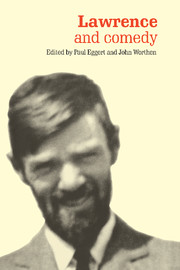Book contents
- Frontmatter
- Contents
- Note on contributors
- Acknowledgements
- Cue-titles
- Introduction
- 1 Drama and mimicry in Lawrence
- 2 Mischief or merriment, amazement and amusement – and malice: Women in Love
- 3 Comedy and hysteria in Aaron's Rod
- 4 D. H. Lawrence and his ‘gentle reader’: The furious comedy of Mr Noon
- 5 ‘Homunculus stirs’: Masculinity and the mock-heroic in Birds, Beasts and Flowers
- 6 Comedy and provisionality: Lawrence's address to his audience and material in his Australian novels
- 7 Lawrence's satiric style: Language and voice in St. Mawr
- 8 Humour in the letters of D. H. Lawrence
- 9 Lawrence to Larkin: A changed perspective
- Index
1 - Drama and mimicry in Lawrence
Published online by Cambridge University Press: 01 March 2010
- Frontmatter
- Contents
- Note on contributors
- Acknowledgements
- Cue-titles
- Introduction
- 1 Drama and mimicry in Lawrence
- 2 Mischief or merriment, amazement and amusement – and malice: Women in Love
- 3 Comedy and hysteria in Aaron's Rod
- 4 D. H. Lawrence and his ‘gentle reader’: The furious comedy of Mr Noon
- 5 ‘Homunculus stirs’: Masculinity and the mock-heroic in Birds, Beasts and Flowers
- 6 Comedy and provisionality: Lawrence's address to his audience and material in his Australian novels
- 7 Lawrence's satiric style: Language and voice in St. Mawr
- 8 Humour in the letters of D. H. Lawrence
- 9 Lawrence to Larkin: A changed perspective
- Index
Summary
The subjects of mimicry and self-mimicry tell us a great deal about Lawrence, not only biographically, but about the kind of interest in drama and the dramatic which he took. This is a side of his life (and his writing) which has been mostly ignored, though the biographical record is full of it. Biographers do not in general know what to do about it, any more than literary critics do. The subjects of mimicry and self-mimicry offer, however, a useful way into some of the patterns of his writing: specifically the kind of performance artistry he employed as a novelist between 1916 and 1923. I shall first describe Lawrence's involvement with the theatre in his early years; then explore his own behaviour as a performer and as a mimic, and how his contemporaries viewed his mimicry; and then show how ideas of theatre and self-mimicry can help to illuminate his own writing performances.
The young Lawrence's overt relationship with the theatre and with ideas of the dramatic is surprising for both its intensity and its variety. He read, went to and wrote plays from the very start of his adult life and in his early years was arguably as fascinated by the theatre as he was by prose fiction – he wrote his first three plays (A Collier's Friday Night, The Widowing of Mrs. Holroyd and The Merry-go-Round) a year before his first novel was published. If we simply examine a period which happens to be reasonably well documented – March 1912 to January 1913 – we find an astonishing variety and intensity in his involvement with drama and the dramatic.
- Type
- Chapter
- Information
- Lawrence and Comedy , pp. 19 - 44Publisher: Cambridge University PressPrint publication year: 1996
- 1
- Cited by



